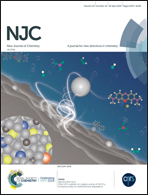Nitrogen-doped hollow carbon spheres functionalized by 9,10-phenanthrenequinone molecules as a high-performance electrode for asymmetric supercapacitors†
Abstract
In this study, uniform nitrogen-doped hollow carbon spheres (NHCSs) have been synthesized using sphere-like SiO2 as a template and polydopamine as a carbon source. It is found that NHCSs have an ultrahigh specific surface area of 870.1 m2 g−1 and high porosity. 9,10-Phenanthrenequinone (PQ) molecules are selected to decorate NHCSs to obtain electrode materials (NHCSs/PQ) for supercapacitors, which show a clear capacitance increase in comparison with pure NHCSs when tested in 1 M H2SO4 aqueous solution. In a three-electrode system, the NHCSs/PQ (mass ratio 4 : 2) electrodes exhibit larger specific capacitance (as high as 252 F g−1 at 1 A g−1) and an ultrahigh rate capability (80.8% capacitance retention at 30 A g−1). Furthermore, the asymmetric supercapacitor is assembled using NHCSs/PQ as a positive electrode material and nitrogen-doped porous carbon (NPCs) that has adsorbed anthraquinone as a negative electrode material, respectively. The device exhibits a high energy density of 8.34 W h kg−1 along with a power density of 600 W kg−1.



 Please wait while we load your content...
Please wait while we load your content...